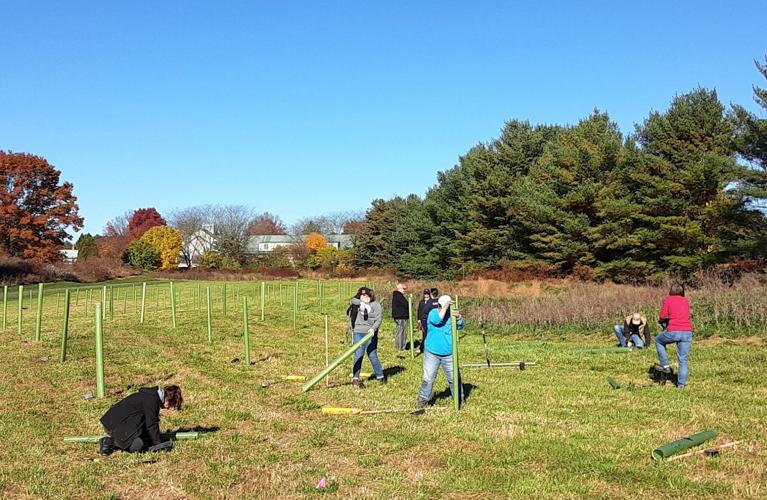By Ad Crable, Bay Journal News Service
When 10 volunteers showed up at 2 a.m. to plant trees in the dark in Lancaster County, Pa., they were offered headlamps, coffee and cans of Red Bull energy drinks in addition to the usual gloves.
Genevieve Chiola, 24, of Lancaster, for one, did not need any stimulants. “It’s kind of wild being awake when I’m not usually awake. I’m energized,” said Ciola, who had never planted a tree before.
“I recently read a lot of books about the power of trees and natural things,” she explained. “I want to be a little more connected to it in my life. I like getting my hands dirty, metaphorically.”
The night owls were the second shift in the inaugural 24-Hour Volunteer Tree Planting Relay dreamed up by the Alliance for the Chesapeake Bay to inspire more tree-planting events in the Chesapeake Bay watershed states, especially along vulnerable streams and in city landscapes.
From 6 p.m. on Friday, Oct. 28, until 6 p.m. the next day, 178 volunteers answered the call, helping 3,500 native trees take root along streams, parks and tucked-away green spots in both rural and urban settings. Six plantings took place in Lancaster, York, Adams and Cumberland counties in Pennsylvania, and one each in Carroll County, Md., and Washington, D.C.
The Treelay, as it’s called, is believed to be the largest single-day volunteer tree-planting event in the Bay states.
“Our main goal for the Treelay was to galvanize communities around tree planting,” said Ryan Davis, the Alliance’s senior forests project manager. “Many people already like trees and the idea of planting them, but most people haven’t ever personally done so.
“By hosting a huge planting event with a fun twist to help make it stick out to the general public, we hoped that we would get new people out to join in, who will then hopefully stay engaged in conservation efforts into the future.”
Among the first tree-planting initiates for the event was Adam Copenhaver, 23, of Rothsville, Pa., who read about the Treelay in his water analysis company’s newsletter. He decided to stay up “as a little bit of ‘why not?’—and to say I’ve done it once in my life. There’s a lot of firsts here tonight.”
The first of three, four-hour shifts in Lancaster County planted 190 trees and shrubs, including river birch, viburnum, sycamore, elderberry, willow and other native species.
They did so under the glare of adjacent baseball field lights that were turned on to illuminate their work.
Like several other sites, the planting followed up previous restoration work. At Salisbury Township Community Park, a summer stream restoration project had converted Plain Sect crop fields into wetlands and native plantings for wildlife and to prevent flooding. During the Treelay, volunteers added a buffer along that stream, as well as a feeder stream that was breathing steam into the chilly night air.
As a heavy frost started to tinge the leaves on the new trees and the thick grass blades, Katie Eckman, a 30-year-old nurse from Lancaster, dug a small hole and bent over to slide a tree ball into the ground.

“Sometimes it’s hard to find ways to give back or to contribute in a way that fights climate change or somehow gives back to environmental causes,” she said. “This is a small thing, but it’s nice to feel like you’re doing something.”
No less earnest were the volunteers who worked at the five other Treelay sites in Pennsylvania. The Treelay’s finale involved adding more than 1,000 trees to a streamside buffer that is converting a former hayfield on a private farm located, symbolically enough, on Good Intent Road outside Gettysburg.
In Westminster, Md., volunteers helped the city revert a former private golf course to a forest.
And in D.C., 10 volunteers each planted a single tree in a small green space in a housing complex.
Working with a trio of nonprofits that support the homeless, runaways and LGBTQ community, the Alliance has spent two years adding to the environmental worth of the small area, creating agriculture gardens, providing a spot for outdoor programs and safe green spaces, and now trees that will literally and figuratively provide fruit.




